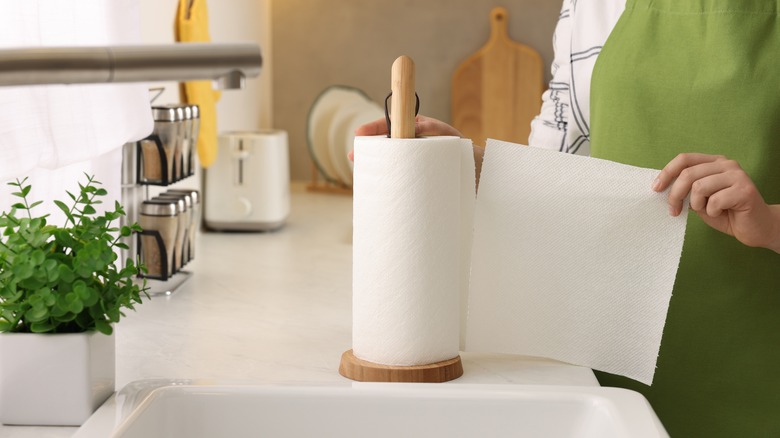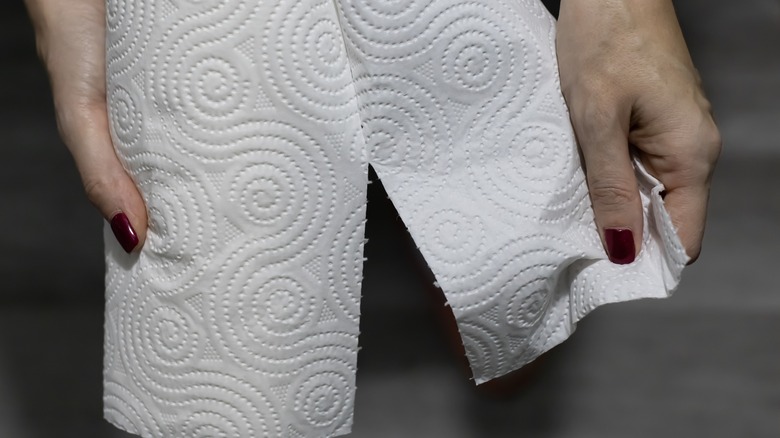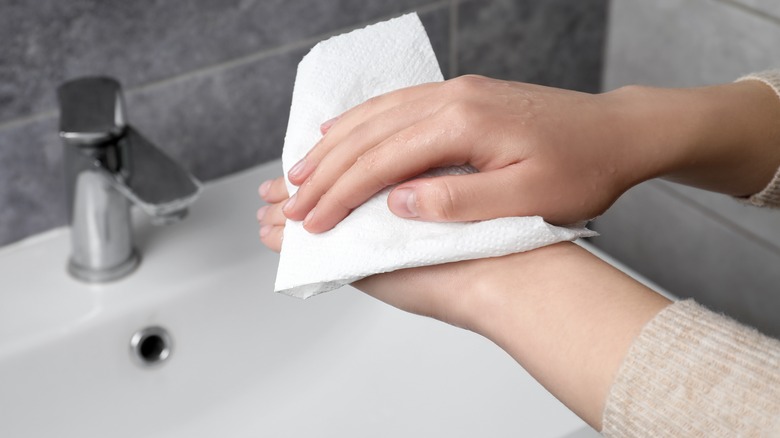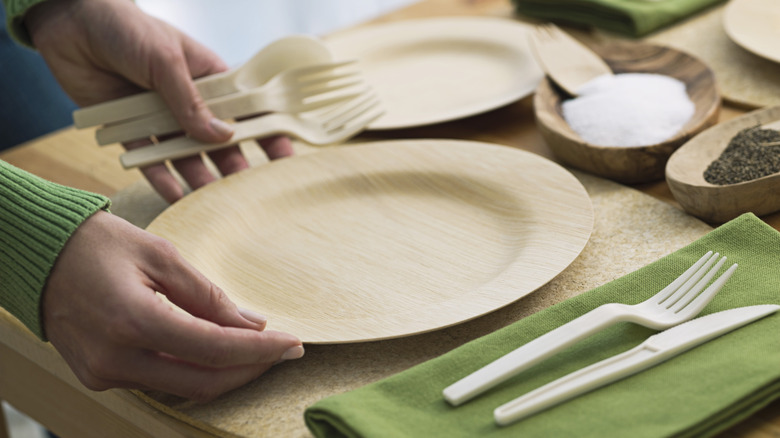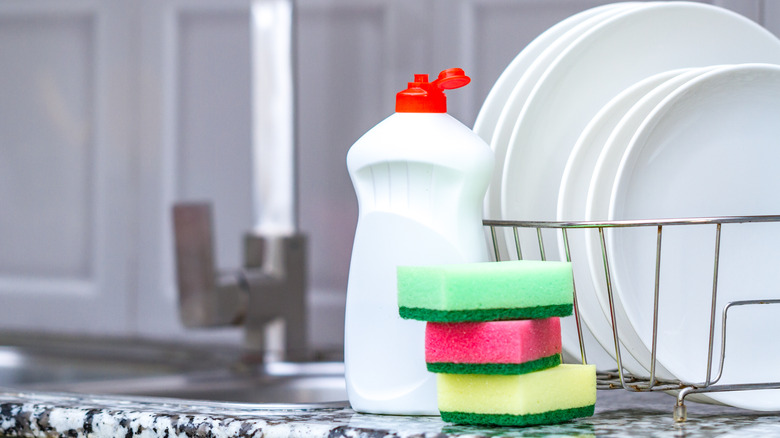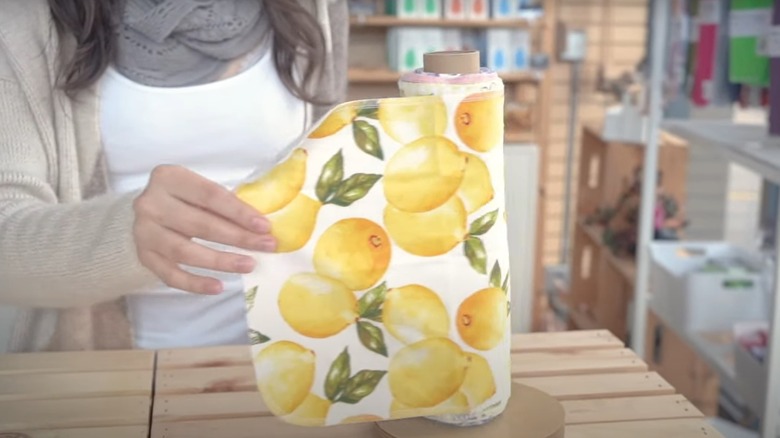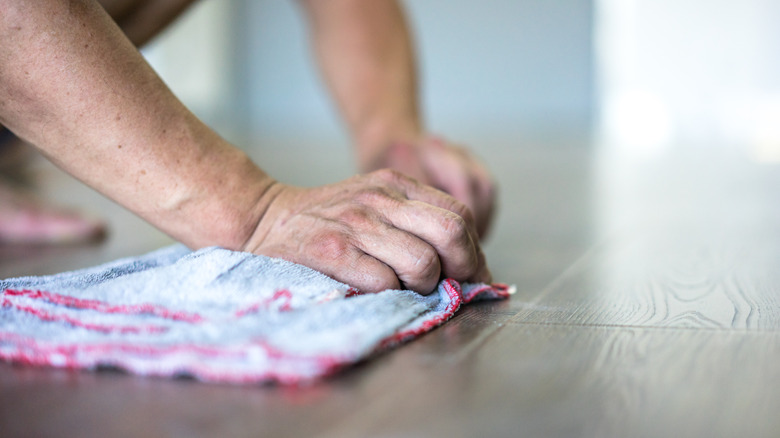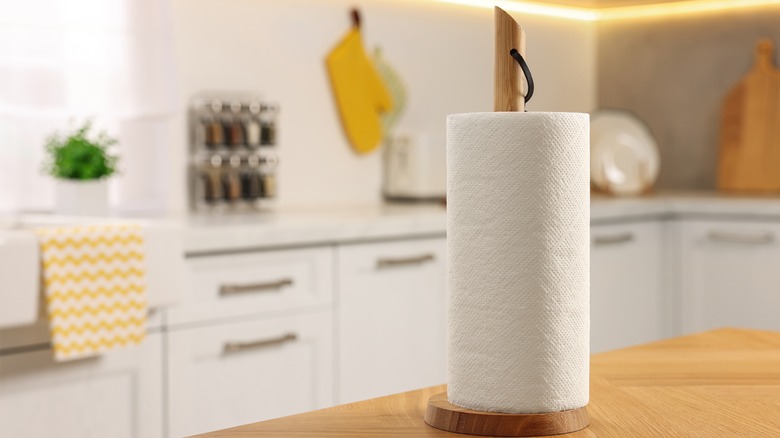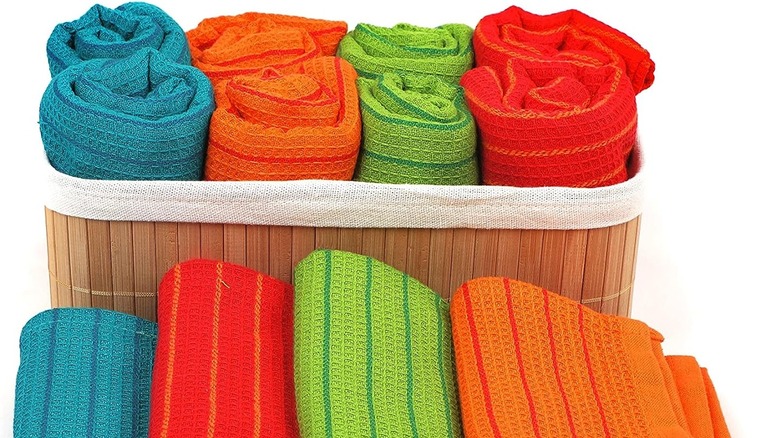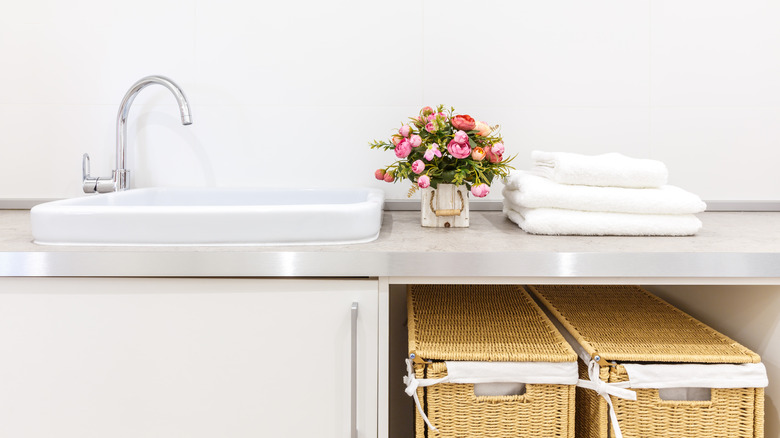The Best Tips For Cutting Back On Paper Towel Use
We may receive a commission on purchases made from links.
If you're like many, you probably find yourself reaching for paper towels to dry your hands after washing them, clean up spills on the floor, wipe your tables and countertops, clean the windows, and so much more. And while they might help make these tasks easier, the truth is that many of us are just using too many of them. In fact, Americans use millions of pounds of paper towels each year. All of this excess waste contributes to overflowing landfills and requires more trees to be chopped down to keep up with consumption.
You don't have to keep following this trend in your household, though. If you're ready to cut back on paper towel usage in your home, there are several small changes that you can make. While you're only one person, small changes can make a big difference. Once you learn how to lower your cleaning waste, you can share your success and inspire others in your life to start taking similar steps.
Tear off small pieces when a full sheet isn't necessary
Have you ever pulled a paper towel off the roll to squish a bug or wipe up a tiny spill on the counter? If so, you likely only used a small section of it and then ended up throwing the whole thing away in the trash can. Just because paper towels have perforated edges that allow you to tear off full- (or even half-) sized sheets, there is no rule stating that you need to take the entire sheet off if you don't need it all.
The next time you reach for a paper towel to clean up a few crumbs on the counter, blot your lipstick, or wipe food residue off one or two fingers, stop yourself from pulling off a full sheet. Instead, only take what you need. Depending on the task, you may be able to get away with using only a corner or a half sheet. Over time, you should notice that you're changing your paper towel roll less often.
Save lightly-used paper towels to use again
While paper towels that have come into contact with raw meat, pet messes, grease, and other particularly dirty things should go straight into the trash can, there are many times when they are not used so heavily. For example, if you're only drying your hands after washing them or cleaning up a little spilled water on the table, do you think the napkin is that dirty? Instead of throwing it out after light cleaning tasks, save the linens to use again.
Leave the paper towels out to dry and grab them — instead of a fresh one from the roll — when you need to clean up a spill on the floor, wipe grease off a pan, or complete various other tasks. The little bit of water or other debris that may have gotten on the towels from their first use certainly isn't going to interfere with them being able to tackle these other messes. You can even "wash" your slightly soiled paper towels by gently rubbing in some dish soap and rinsing them out with clean water. Then, designate a spot to let the towels dry, so they're ready to help you out with future cleaning needs.
Switch to cloth napkins for meal times
How many paper towels or napkins do you go through each day during meals? If four people are in your house, you likely use at least one for each person for each meal. This works out to 12 each day, 84 each week, 336 each month, and, wait for it, over 4,000 each year. Until you do the math, you may not realize how much waste you're creating by using paper napkins at your dining table.
Fortunately, you can quickly put a stop to this trend by switching to cloth napkins. Cloth napkins are easy to clean and can be reused several times. Invest in a few different sets, and you won't need to worry about doing laundry too often. With cloth, you can even choose different patterns and colors to add some style to your dining table. However, you might want to opt for darker colors, as stains won't be as noticeable on them.
Invest in a few more kitchen towels
Just as switching to cloth napkins can help you cut back on waste around the dining table, adding more dish towels and rags to your kitchen can help you conserve paper towels. With more cloth towels easily accessible, you and others in the home will be more likely to reach for them when drying dishes or your hands.
Set yourself up for success by placing them in convenient locations. For example, hang a towel bar near your kitchen sink — ideally closer than where the paper towels are located. If your sink is close to your refrigerator, you can even find magnetic bars you can hang without drilling any holes in your walls. You might find it best to have two separate towels — one for drying hands and one for drying dishes. Store a stack of them somewhere in the kitchen to make pulling out a clean one more convenient.
Make use of your sponges
If you only use your sponge for cleaning dishes, it is time to start putting it to better use. Sponges are ideal for sopping up spilled water and other liquidy messes. Think about how many paper towels it takes to clean up a glass of spilled water. With a sponge, you can sop up some water, squeeze the excess out over the sink, and return to continue removing the liquid.
If you're worried about contaminating your dishes by using your sponges for "dirtier" cleaning tasks, then just leave a few different ones out on the counter. If you find a pack with a variety of colors, you can easily keep track of which one is for which types of tasks. Sponges will absorb odors and hold on to bacteria, so cleaning them regularly — either in the dishwasher or in the microwave — is a good idea.
Try unpaper towels
There is something very convenient about a roll of paper towels. You pull one sheet from the roll, and the rest remains there, ready for use. Some people don't want to give up this convenience by switching to a stack of cloth towels. Fortunately, there is a third option: Try unpaper towels.
Unpaper towels offer all the convenience of their disposable counterparts without the waste. The pieces of cloth cling together thanks to the special design of the fabric. This allows you to roll them up for convenient use. When you need a sheet, just pull off one "towel," use it however you want, and then toss it in a laundry hamper instead of the trash can. Once the basket is full, wash the sheets and roll them around a tube or stand. If you want to cut back on your waste by trying this innovative and eco-friendly product, you can purchase a roll from Marley's Monsters.
Keep a floor rag handy
One thing that may be holding you back from getting the paper towels out of your kitchen is thinking about cleaning up dirty messes. If you switch to using kitchen towels, you may be turned off by the idea of using the same towel for cleaning the counter that you also use for cleaning up spills on the floor. Similarly, you might feel like you're going to accumulate a lot of laundry if you end up having to toss each one into the hamper after using it for a small floor clean-up task.
There, fortunately, is a simple workaround to this problem. Set a few old towels aside to be your dedicated floor rags. In many cases, you'll be able to use the same one to clean up multiple messes from the floor before it needs to be cleaned. Just find somewhere you can hang the rags up to dry between uses, such as the inside of the cabinet beneath your sink. When the towel gets too dirty or comes into contact with juices from raw meat, set it aside to wash and pull out a clean rag for future tasks.
Change where you store your rolls of paper towels
Even after you bring reusable cloth towels into your kitchen, it can be difficult to break old habits. You may find that you're still reaching for that paper roll, even if the alternatives are nearby. To stop yourself from making this mistake, there is a simple solution: Move the roll to a less convenient location.
Instead of leaving them on the kitchen counter right by the sink, move the roll across to the other side of the room. This causes friction, making it more difficult to take the easy way out. This way, when you need to dry your hands, wipe up a mess, or dry a pot you just washed, you won't "accidentally" grab something that will end up in the trash. Instead, you'll start teaching yourself to reach for the eco-friendly options you have instead of walking across the room to get a paper towel.
Color-code your towels for different types of cleaning tasks
As you start cutting paper towels out, you'll find that you are using cloth options for tons of tasks around the home. In addition to using them to dry your hands and dishes in the kitchen, you may discover the benefits of using them to clean your bathroom counters, dust your furniture, or even clean the toilets. While finding more and more ways to put reusable options to work is great, the thought of drying your hands using a towel that recently was used to clean the toilet — even if it was washed first — is probably less than appealing.
Don't let this deter you from making the switch to more eco-friendly options, though. Instead of using the same towels for all your cleaning needs, use a different set for each type of task. Buying colored cloths can help make it easy to keep them apart. For example, red can be earmarked for bathroom tasks, while blue can be for dusting. You can even wash separate loads of laundry if you're worried about spreading germs or bacteria.
Make sure you have a hamper in a convenient location
When you finish cleaning something with a reusable cloth, you'll want to put it in a hamper until you have enough for a full load of laundry. With how many towels you'll be going through, the last thing you'll want to do is to walk upstairs, downstairs, or to some other "far away" location in your home to put each used towel in the hamper. An easy fix for this potential problem is to purchase a few additional hampers to leave around the house.
One location you'll definitely want to leave a hamper is in the kitchen. Tossing a cloth in it once you're done cleaning will match the ease of throwing a paper towel in the trash can. If you don't have extra floor space in your kitchen or don't want the hamper to be so visible, consider purchasing a small bin that can be stored inside one of your cabinets.
